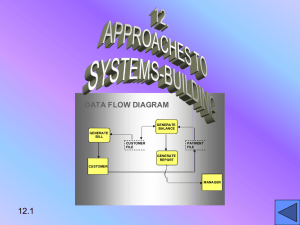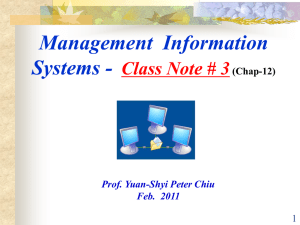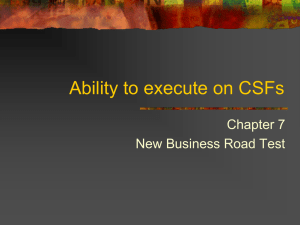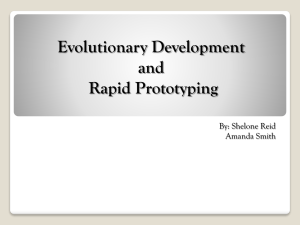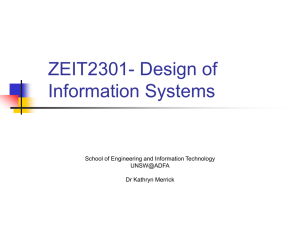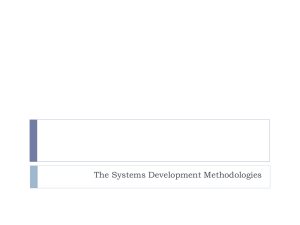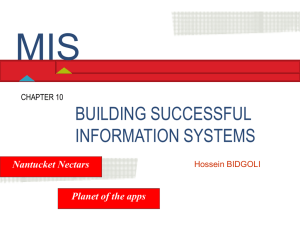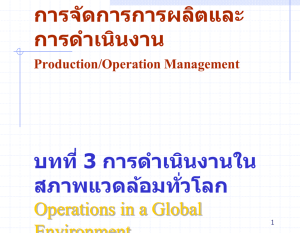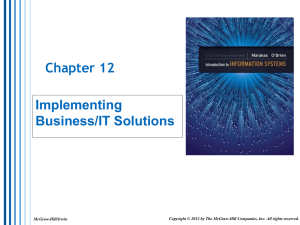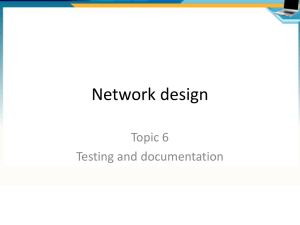11 - Department of Computer Engineering
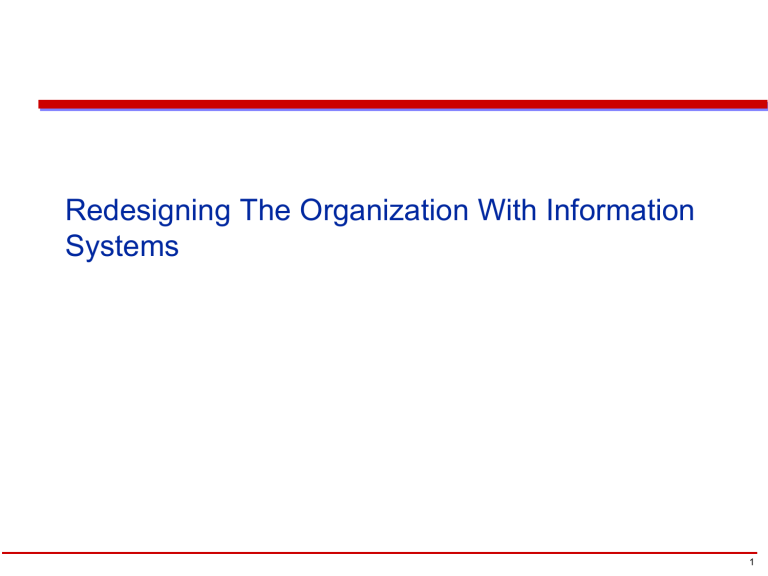
Chapter
Redesigning The Organization With Information
Systems
1
Objectives
Demonstrate how building new systems produces organizational change
Explain how a company can develop information systems that fit its business plan
Identify and describe the core activities in the systems development process
2
Objectives
Evaluate alternative methods for building information systems and alternative methodologies for modeling systems
Assess the challenges of building information systems and management solutions
3
Management Challenges
Major risks and uncertainties in systems development
Determining when new systems and business processes can have the greatest strategic impact
4
Linking Information Systems to the
Business Plan
Organizations need to develop an information systems plan that supports their overall business plan and in which strategic systems are incorporated into top-level planning
Information systems plan
Identifies the direction of systems development, the rationale, the current situation, the management strategy, the implementation plan, and the budget
5
Information
Systems Plan
6
Establishing Organizational Info.
Requirements
Two principal methodologies for establishing the information requirements of the organization as a whole:
Enterprise analysis
Critical success factors
7
Enterprise Analysis
(Business Systems Planning)
Examines the entire organization in terms of organizational units, functions, processes, and data elements; helps identify the key entities and attributes in the organization’s data
The central method used in the enterprise analysis approach is to take a large sample of managers and ask them :
how they use information,
where they get their information, what their objectives are, how they make decisions, and what their data needs are.
The results of this large survey of managers are aggregated into subunits, functions, processes, and data matrices.
Data elements are organized into logical application groups
(groups of data elements that support related sets of organizational processes. )
8
Process/Data Class Matrix
(Ex. Social Security Administration)
Figure 14-1
9
Disadvantages of Enterprise Analysis
Produces an enormous amount of data that is expensive to collect and difficult to analyze.
The questions frequently focus not on management’s critical objectives and where information is needed but rather on what existing information is used.
The result is a tendency to automate whatever exists
But in many cases, entirely new approaches to how business is conducted are needed, and these needs are not addressed.
10
Strategic Analysis or Critical Success
Factors (CSFs):
The strategic analysis, or critical success factors, approach argues that an organization’s information requirements are determined by a small number of critical success factors (CSFs) of managers.
If these goals can be attained, success of the firm or organization is assured (Rockart 1979; Rockart and Treacy,
1982).
CSFs: Operational goals shaped by the industry, the firm, the manager, and the broader environment that are believed to assure the success of an organization
The CSF approach relies on interviews with key managers to identify their CSFs. Individual CSFs are aggregated to develop
CSFs for the entire firm. Systems can then be built to deliver information on these CSFs.
11
Using CSFs to Develop Systems
Figure 14-2
12
Disadvantages of Strategic Analysis
What may be considered critical to a manager may not be important for the organization as a whole.
This method is clearly biased toward top managers, although it could be extended to elicit ideas for promising new systems from lower-level members of the organization
13
The Spectrum of Organizational Change
Automation: Mechanizing procedures to speed up the performance of existing tasks
Rationalization of procedures: The streamlining of standard operating procedures
Business process reengineering: Analysis and redesign of business processes to reorganize workflows and reduce waste and repetitive tasks
Paradigm shift: Radical reconceptualization of the nature of the business and the nature of the organization
14
Organizational Change Carries Risks and
Rewards
Figure 14-3
15
Business Process Reengineering
Business Process Reengineering
Reorganizes work flows, combining steps to eliminate redundant paper-intensive tasks
Large payoff from IT investment if processes are redesigned before applying technology
16
Workflow Management
The process of streamlining business procedures so that documents can be moved easily and efficiently from one location to another
17
Steps in Effective Reengineering
Understanding which processes need improvement
Measuring performance of existing processes as a baseline
Allowing IT to influence process design from the start
18
Redesigning Mortgage Processing in the
United States
Figure 14-4
19
Business Process Management (BPM):
Methodology and tools for revising the organization’s business processes enabling continual improvements
BPM and BPM software tools include:
Workflow management
Business process modeling
Quality management
Change management
Tools for recasting processes into standardized forms that can be continually manipulated
Process mapping tools to document existing processes and create new models
Process monitoring and analytics
20
Overview Of Systems Development
Systems development
The activities that go into producing an information system solution to an organizational problem or opportunity
21
The Systems Development Process
22
The Systems Development Process
ACTIVITY
Systems analysis
DESCRIPTION
Identify problem(s)
Specify solutions
Establish information requirements
Create design specifications Systems design
Translate design specifications into code Programming
Testing
Conversion
Production and maintenance
Unit test
Systems test
Acceptance test
Plan conversion
Prepare documentation
Train users and technical staff
Operate the system
Evaluate the system
Modify the system
23
The Systems Development Process
Systems analysis
Analysis of problem
Defining the problem and identifying causes
Specifying solutions
Written systems proposal report describes costs and benefits of each alternative solution
Identifying information requirements to be met
Who needs what information where, when, and how
Includes feasibility study
Is solution a good investment?
Is required technology, skill available?
24
The Systems Development Process
Systems design
Describe system specifications that will deliver functions identified during systems analysis
Should address all managerial, organizational, and technological components of system solution
Role of end users
User information requirements drive system-building
Users must have sufficient control over design process to ensure that system reflects their business priorities and information needs
Insufficient user involvement in design effort is major cause of system failure
25
Design Specifications
OUTPUT
Medium
Content
Timing
INPUT
Origins
Flow
Data entry
USER INTERFACE
Simplicity
Efficiency
Logic
Feedback
Errors
DATABASE DESIGN
Logical data model
Volume and speed requirements
File organization and design
Record specifications
PROCESSING
Computations
Program modules
Required reports
Timing of outputs
MANUAL PROCEDURES
What activities
Who performs them
When
How
Where
CONTROLS
Input controls (characters, limit, reasonableness)
Processing controls (consistency, record counts)
Output controls (totals, samples of output)
Procedural controls (passwords, special forms)
SECURITY
Access controls
Catastrophe plans
Audit trails
DOCUMENTATION
Operations documentation
Systems documents
User documentation
CONVERSION
Transfer files
Initiate new procedures
Select testing method
Cut over to new system
TRAINING
Select training techniques
Develop training modules
Identify training facilities
ORGANIZATIONAL CHANGES
Task redesign
Job redesign
Process design
Organization structure design
Reporting relationships
26
The Systems Development Process
Programming:
System specifications from design stage are translated into software program code
Software may be purchased, leased, or outsourced instead
Testing
To ensure system produces right results
Test plan: All preparations for series of tests
Unit testing: Tests each program in system separately
System testing: Tests functioning of system as a whole
Acceptance testing: Makes sure system is ready to be used in production setting
27
A Sample Test Plan to Test a Record
Change
28
The Systems Development Process
Conversion
Process of changing from old system to new system
Four main strategies
Parallel strategy
Direct cutover
Pilot study
Phased approach
Requires end-user training
Finalization of detailed documentation showing how system works from technical and end-user standpoint
29
The Systems Development Process
Production and maintenance
System reviewed to determine if any revisions needed
May prepare formal post-implementation audit document
Maintenance
Changes in hardware, software, documentation, or procedures to a production system to correct errors, meet new requirements, or improve processing efficiency
60 percent of maintenance work:
User enhancements
Improving documentation
Recoding system components for greater processing efficiency
30
Modeling and Designing Systems:
Structured Methodologies:
Process-oriented development and modeling methods
Top-down, progressing from the highest (most abstract) level to the lowest (most specific) level of detail
Separates data from processes
Separate programming procedures written for each new action taken on a piece of data
31
Structured Methodologies: (tools)
Data Flow Diagram (DFD): Logical graphic model of information flow, partitioning system into modules that show manageable levels of detail
Structure charts: Hierarchical charts showing each level of design, its relationship to other levels, and its place in the overall design structure
Process Specifications: Describe the transformation occurring within the lowest level of the data flow diagrams. They express the logic for each process
32
Data Flow Diagram for Mail-in University
Registration System
Figure 14-7
33
High-level Structure Chart for a Payroll
System
Figure 14-8
34
Object-Oriented Development:
Uses the object as the basic unit of systems analysis and design
Objects combine data and processes use on the data
Use class and inheritance to group objects and apply common embedded procedures
Development is more iterative and incremental than structured development.
Analysis identifies objects, classes of objects, and behavior of objects.
35
Class and Inheritance
Figure 14-9
36
Unified Modeling Language (UML):
Industry standard for representing various views of an object-oriented system using a series of graphical diagrams
Two principal types of diagrams
Structural diagrams: Describe the relationship between classes
Behavioral diagrams: Describe interactions in an objectoriented system
37
Computer-Aided Software Engineering
Software tools to automate development and modeling methodologies
Enforce a standard development methodology and design discipline
Improve communication between users and technical specialists
Organize and correlate design components and provide rapid access to them using a design repository
Automate tedious and error-prone portions of analysis and design
Automate code generation and testing and control rollout
39
Alternative Systems-building Approaches
Systems life cycle:
Traditional methodology with sequential, formal stages and a formal division of labor between end users and information systems specialists
Prototyping / Iterative processes:
Building an experimental system quickly and inexpensively for demonstration and evaluation and used as a template for the final system
40
Prototyping
Prototyping
Process of building experimental system quickly and inexpensively for demonstration and evaluation
Prototype
Preliminary working version of information system for demonstration and evaluation
41
Prototyping
Iterative
A process of repeating over and over again the steps to build system
42
The Prototyping Processes
Figure 14-11
43
Steps in Prototyping
1)
Identifying user’s basic requirements
2)
Developing initial prototype
3)
Using prototype
4)
Revising and enhancing prototype
44
Advantages and Disadvantages of
Prototyping
Advantage
Useful in designing information system’s end-user interface
Disadvantage
Rapid prototyping can gloss over essential steps in systems development
45
Application Software Packages
Application software packages
Prewritten, precoded application software programs that are commercially available for sale or lease
May include customization features allowing the software to be modified for an organization’s unique requirements
46
The Effects of Customizing a Software
Package on Total Implementation Costs
47
Application Software Packages
Package evaluation criteria:
Functions, flexibility, user friendliness, hardware and software resources, database requirements, installation and maintenance efforts, documentation, vendor quality, cost
Request for Proposal (RFP)
A detailed list of questions submitted to vendors of software or other services to determine how well the vendor’s product will meet the organization’s specific requirements
48
End-User Development
Development of information systems by end users with little or no formal assistance from technical specialists
Allows users to specify their own business needs
49
Managing End-User Development
Information Center: A special facility within an organization that provides training and support for end-user computing
50
End-User Versus System Lifecycle
Development
51
End-User Development
Improves requirements gathering leading to higher level of user involvement and satisfaction
Cannot easily handle processing of large numbers of transactions or applications
52
Outsourcing
Contracting computer center operations, telecommunications networks, or applications development to external vendors
Benefits from economies of scale and complementary core competencies
Disadvantages may be hidden costs, loss of control
53
Component-Based Development:
Building large software systems by combining preexisting software components
54
Comparison of Systems-Development Approaches
55
Rapid Application Development (RAD)
Process for developing systems in a short time period
Uses prototyping, fourth-generation tools, and close teamwork among users and systems specialists
56
The Web services architecture
57
Web Services and Service-Oriented
Computing:
Web services can be used as tools for building new information system applications or enhancing existing systems.
Web services can create software components that are deliverable over the Internet and provide new functions for an organization’s existing systems or create new systems that link an organization’s systems to those of other organizations
58
